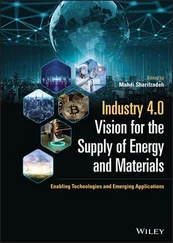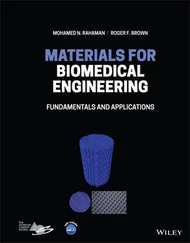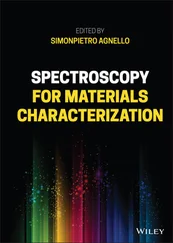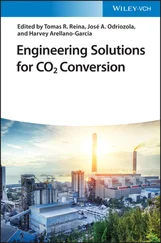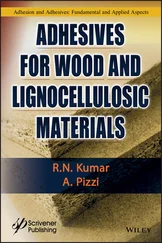Materials for Solar Energy Conversion
Здесь есть возможность читать онлайн «Materials for Solar Energy Conversion» — ознакомительный отрывок электронной книги совершенно бесплатно, а после прочтения отрывка купить полную версию. В некоторых случаях можно слушать аудио, скачать через торрент в формате fb2 и присутствует краткое содержание. Жанр: unrecognised, на английском языке. Описание произведения, (предисловие) а так же отзывы посетителей доступны на портале библиотеки ЛибКат.
- Название:Materials for Solar Energy Conversion
- Автор:
- Жанр:
- Год:неизвестен
- ISBN:нет данных
- Рейтинг книги:5 / 5. Голосов: 1
-
Избранное:Добавить в избранное
- Отзывы:
-
Ваша оценка:
- 100
- 1
- 2
- 3
- 4
- 5
Materials for Solar Energy Conversion: краткое содержание, описание и аннотация
Предлагаем к чтению аннотацию, описание, краткое содержание или предисловие (зависит от того, что написал сам автор книги «Materials for Solar Energy Conversion»). Если вы не нашли необходимую информацию о книге — напишите в комментариях, мы постараемся отыскать её.
This book provides professionals and students with a resource on the basic principles and applications of solar energy materials and processes, as well as practicing engineers who want to understand how functional materials operate in solar energy conversion systems.
Audience
Materials for Solar Energy Conversion — читать онлайн ознакомительный отрывок
Ниже представлен текст книги, разбитый по страницам. Система сохранения места последней прочитанной страницы, позволяет с удобством читать онлайн бесплатно книгу «Materials for Solar Energy Conversion», без необходимости каждый раз заново искать на чём Вы остановились. Поставьте закладку, и сможете в любой момент перейти на страницу, на которой закончили чтение.
Интервал:
Закладка:
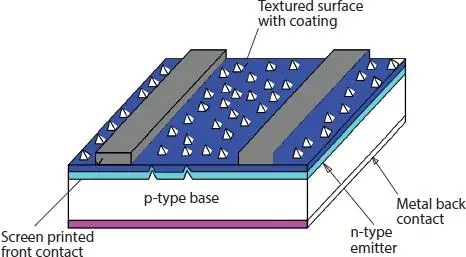
Figure 2.2 Single-crystalline PV cells.
2.3 Second-Generation Solar PV Technology
Table 2.2listed manufacturers of second-generation photovoltaic solar cells. It is single connection device, which uses lesser materials and continuing efficiency as first-generation PV cells. Second-generation PV cells, namely, cadmium sulfide/cadmium telluride, amorphous, and multi-crystalline silicon, can be deposited on low expensive substrate called glass. These materials have higher efficiency compared to single-crystalline and multi-crystalline solar cells, and 1- to 10-micrometer materials are only utilized for solar cell fabrication. Light trapping technology has been used to increase efficiency of polycrystalline materials upto 10%.
2.3.1 Amorphous Silicon PV Cell
One or more PV solar cell materials are deposited on the substrate, which is called amorphous silicon. Figure 2.3shows amorphous silicon photovoltaic solar cell. Vapor depositing technology is used to deposit 1-micrometer silicon materials on substrate (glass or metal). Depositing temperature is upto 75°C for plastic material as substrate. One of major drawbacks is, when exposed to sunlight, degradation has been happened in their output power. Electric field strength is to be increased when thickness of material reduced [3, 26]. Unisolar is a company which inventing solar PV cells using silicon thin film. The three-layer system can be used to optimize absorbing sun light from solar spectrum.
Table 2.2 Second-generation PV cells.
| Manufacturer | Country | Technology |
| Amysolar | France | Amorphous silicon |
| 3sun | Italy | Amorphous silicon |
| Anwell Precision | Hong Kong | Amorphous silicon |
| EcoMedia | Italy | Cadmium sulfide/cadmium telluride |
| Dupont | United States of America | Copper indium gallium diselenide |
| Nexcis | France | Copper indium gallium diselenide |
| First Solar | United States of America | Copper indium gallium diselenide |
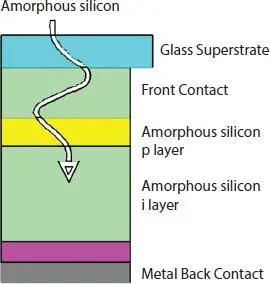
Figure 2.3 Amorphous silicon PV cell.
2.3.2 Cadmium Telluride PV Cell
Cadmium telluride is a thin layered film semiconductor, which is used to convert receiving solar light into electrical energy [25]. The cadmium PV solar cell consists of two layers, which are top and bottom layers; the bottom layer is made up of carbon paste and top layer is made up of cadmium built stannous oxide or tin oxide, which is shown in Figure 2.4. Cadmium telluride is located between the top layer and semiconductor. The cadmium telluride-based solar PV cells are the second highest technology available in the market after the crystalline silicon. Among the different types of solar PV cells available in the world market nearly 7% is cadmium telluride.

Figure 2.4 Cadmium telluride PV cell.
The major advantages of this type of solar PV cells are time and cost for manufacturing is lower, and it can also be replaced by conventional silicon PV technologies. In total production, 21.5% of cadmium telluride–based PV cells are fabricated by First Solar, and its efficiency is 14.7% [13].
2.3.3 Copper Indium Gallium Diselenide PV Cells
The copper indium gallium diselenide PV cells have higher energy generated capacity compared to any other solar PV cell technology, which is shown in Figure 2.5. Power production rate on glass substrate increased upto 20%. Recent advancement in solar PV cells is PV devices and metal or polyamide as substrate. It can be applicable in space application due to its advantages like flexibility, opposing to solar radiation and maximum specific power. It is having highest solar light absorbing coefficient, and band width is 15 eV [15].
2.4 Third-Generation PV Cells
Third-generation PV cells’ objective is to use very thin film for power production compared to second-generation PV cells. Different manufacturers of third-generation photovoltaic cells are listed in Table 2.3. The perception is to do diminish the cost per watt peak with small intensification of areal cost. Availability of raw material is higher and being harmless is the basic requirement; it common for both second and third generation. Third-generation solar PV cells are very much suitable for mass production. This type of PV cells is not giving as much efficiency and quality of single crystal PV cells [10].
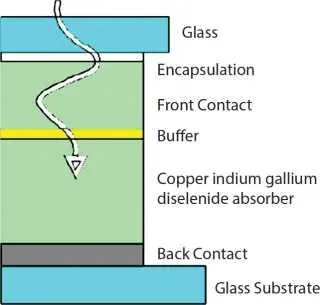
Figure 2.5 Cadmium indium gallium diselenide PV cell.
Table 2.3 Third-generation PV cells.
| Manufacturer | Country | Technology |
| Amo Solar | Korea | Dye Sensitized |
| Bloo Solar | United States of America | Copper zinc tin sulfide |
| G24 Power | United Kingdom | Dye Sensitized |
| Heliatek | Germany | Organic Polymer |
| Samsung Electronics | Korea | Dye Sensitized |
| Solar Ivy | Unites States of America | Organic Polymer |
| Solterra Renewable | Unites States of America | Quantum Dot |
| Timo Technology | Korea | Dye Sensitized |
| Voxtel | Unites States of America | Quantum Dot |
2.4.1 Copper Zinc Tin Sulfide PV Cell
Copper zinc tin sulfide is a forth order semiconducting compounds, increasing interest toward application of solar PV cells. Similar to this material, namely, sulfur selenium alloy, copper zinc tin selenide. These materials have electronic and optical properties same as that of cadmium indium gallium diselenide; hence, it is well suited for solar PV cells applications. It comprises abundant availability and harmless elements. It improves efficiency of solar cells upto 12% compared to cadmium-based and crystalline-based solar cells, and more effort is required to be commercialized in the market [10]. Copper zinc tin sulfide belongs to forth order compound as shown in Figure 2.6. Copper zinc tin sulfide PV cell can attain by replacing the bivalent Zink, trivalent indium, and gallium and tetravalent tin, which forms like kesterite structure. Few authors are reported this PV cell structure in the forms of stannite structure but it is not clear as much of kesterite structure. Crystal energy for stannite is 2.86 meV per atom higher compared to kesterite structure [23]. However, common defect occurred is structure resolution retarded by disarray of the copper and zinc cations.
2.4.2 Dye Sensitized PV Cell
It consists of transparent conducting glass, titanium oxide (TiO 2) nanoparticles, dyes, electrodes, and counter electrode as shown in Figure 2.7. Glass substrate layer is in the top, which permits sunlight into the cell simultaneously conducting electrons transfer to external circuit. Titanium oxide nanoparticles are used as anode materials also called negatively doped; it has high photosensitivity and stability. Dye molecules are very important for increasing efficiency through absorbing visible light photons. Natural colorings and synthetic dyes act as donor and acceptor, respectively, which enhance current density and absorbing capacity of infrared region. Three different kinds of electrolytes have been used for the PV cells, namely, inorganic solvents, inorganic ionic liquids produced with salt or mixure salts, and solid electrolyte such as iodine free gel electrolyte. In the backside of dye sensitized cell, another glass substrate is covered by platinum as catalyst and produces cathode materials. It is very low expensive and more appropriate to a thin film solar cell group [19]. Working of dye sensitized PV cells is based on semiconductor that is devised between an electrode and photo sensitized anode in electrochemical system. The advanced dye solar PV cell is also called Gratzel cell, which is invented by B.O’Reganand and M.Gratzel at UC Berkeley in 1988 [4]. Later, it has been developed by scientist at Ecole Polytechnique, Lausanne in 1991 [14]. In 2010, M. Gratzel has honored with Millennium Technology prize for this innovation [20]. This type of cells has more advantages compared to other type of cells, which are cost effective, flexible, and transparent. It has been avoided number of high cost materials such as ruthenium and platinum. Presence of liquid electrolyte makes difficulty in terms of making appropriate in all weather conditions. However, its power conversion efficiency is low compared to other high expensive solar cells. The efficiency of this system should be high than only it can compete with commercially available solar cells.
Читать дальшеИнтервал:
Закладка:
Похожие книги на «Materials for Solar Energy Conversion»
Представляем Вашему вниманию похожие книги на «Materials for Solar Energy Conversion» списком для выбора. Мы отобрали схожую по названию и смыслу литературу в надежде предоставить читателям больше вариантов отыскать новые, интересные, ещё непрочитанные произведения.
Обсуждение, отзывы о книге «Materials for Solar Energy Conversion» и просто собственные мнения читателей. Оставьте ваши комментарии, напишите, что Вы думаете о произведении, его смысле или главных героях. Укажите что конкретно понравилось, а что нет, и почему Вы так считаете.


